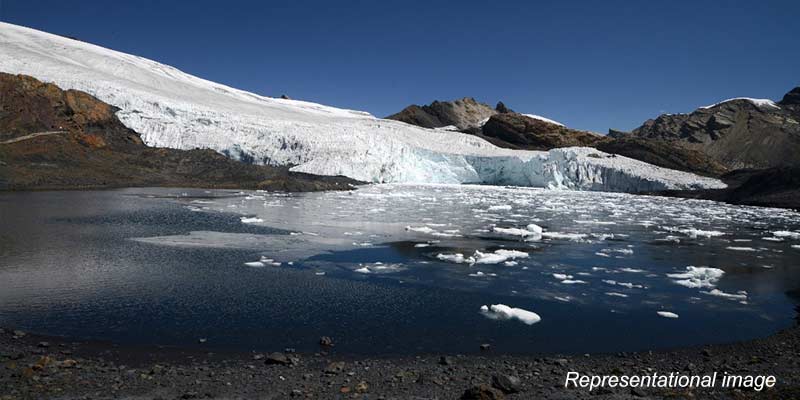- World
- Jan 01
UN observes 2025 as the ‘International Year of Glaciers’ Preservation’
• The year 2024 is set to be the warmest on record, capping a decade of unprecedented heat fuelled by human activities, according to the World Meteorological Organisation (WMO). Greenhouse gas levels continue to grow to record observed highs, locking in even more heat for the future.
• The WMO will publish the consolidated global temperature figure for 2024 in January and its full State of the Global Climate 2024 report in March 2025.
• In 2025, there will be a strong focus on the cryosphere — the frozen parts of the Earth including sea ice, ice sheets, frozen ground — as it is the International Year of Glaciers’ Preservation, facilitated by UNESCO and WMO.
Climate catastrophes
• Throughout 2024, a series of reports from the WMO community highlighted the rapid pace of climate change and its far-reaching impacts on every aspect of sustainable development.
• Record-breaking rainfalls were documented as well as catastrophic flooding, scorching heat waves with temperatures exceeding 50°C, and devastating wildfires.
• The WMO found that climate change added 41 days of dangerous heat in 2024, harming human health and ecosystems in their report.
• Climate change also intensified 26 of the 29 weather events studied by World Weather Attribution that killed at least 3,700 people and displaced millions.
• As global temperatures rise and extreme heat events become more frequent and severe, there is a growing need for enhanced international cooperation to address extreme heat risks.
International Year of Glaciers’ Preservation
• In December 2022, the UN General Assembly adopted the resolution to declare 2025 as the International Year of Glaciers’ Preservation, accompanied by the proclamation of March 21 of each year as the World Day for Glaciers starting in 2025.
• With 2025 designated as the International Year of Glaciers’ Preservation, WMO and the UN Educational, Scientific and Cultural Organisation (UNESCO) aim to prioritise efforts to protect the cryosphere — the Earth’s frozen regions, critical to regulating global temperatures.
• The UN aims to highlight the importance of glaciers and ensure that those relying on them, and those affected by cryospheric processes, receive the necessary hydrological, meteorological, and climate services. These efforts underscore the critical role mountain regions play as a key source of global freshwater and ecosystem services.
• It is an opportunity to raise global awareness about the critical role of glaciers, snow and ice in the climate system and the hydrological cycle, and the economic, social and environmental impacts of the impending changes in the Earth’s cryosphere.
The dynamics of glaciers
• Glaciers are bodies of moving ice that develop as snow accumulated in cold places compacts and recrystallizes. The formation of a glacier takes decades to millennia, and its size varies depending on the amount of ice it retains throughout its lifespan.
• Each year, glaciers gain and lose mass. They gain mass from snow and precipitation in their upper portions (accumulation zone) and lose mass in their lower portions (ablation zone) by partially melting in summer. In marine-terminating glaciers, they also lose mass by calving icebergs that float away.
• The balance between accumulation and ablation is the mass balance of the glacier. If accumulation is greater than ablation, then the glacier has a positive mass balance and will advance. If ablation is greater than accumulation, then the glacier has a negative mass balance and will retreat.
• The glacier terminus is the end of a glacier at any given point in time. Changes in the terminus position are often used as an important indicator for monitoring the long-term dynamic behavior of glaciers.
• Earth’s glaciers vary incredibly in their sizes and shapes, ranging from small cirque glaciers to ice masses hundreds of meters thick in mountains and ice sheets.
There are two main groups of glaciers:
i) Unconstrained glaciers have a morphology and flow pattern largely independent of underlying topography, like polar ice caps or the Antarctic and Greenland ice sheets.
ii) Constrained glaciers have a morphology and flow pattern strongly dependent on underlying topography, like ice field, cirque, valley, piedmont and tidewater glaciers.
Accelerated melting of glaciers
• The melting of glaciers affects everyone: people living in coastal areas affected by sea level rise, people living in high mountain areas more prone to the risks of flooding, landslides and avalanches, and people living in downstream areas that are dependent on water supply from glaciers.
• Melting glaciers and ice sheets were identified as one of the largest contributors of sea level rise in the past decades.
• Glaciers in UNESCO World Heritage sites are melting at an alarming rate, with a third of the sites set to disappear by 2050. In the same time frame, most remaining tropical glaciers in South America, Africa and Asia will vanish. Glacier loss is also accompanied by the loss of biodiversity, especially of endemic species, as well as the loss of cultural values and traditional ways of life.
• Glacier retreat clearly presents a serious threat to natural and human water supplies in many parts of the world.
Manorama Yearbook app is now available on Google Play Store and iOS App Store



